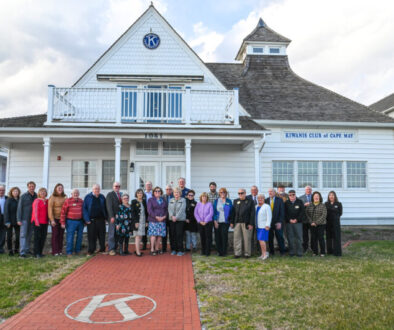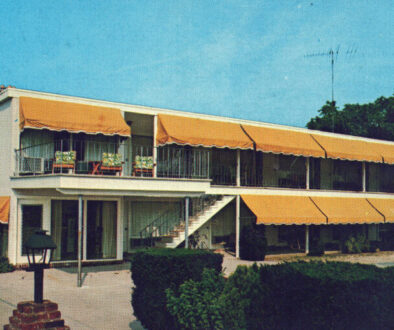From the Director’s Chair
Roy Steinberg looks back at 15 years with Cape May Stage during its 35-year anniversary
The control room of a network television show resembles an airport control tower, with a cacophony of directions given to the various camera operators. There is a wall of television monitors showing what each camera is shooting, and the “line monitor” which is what the viewers will see. Facing that wall is a production assistant timing the show and taking notes from the producer shouting over the directions to the camera operators, an assistant director telling what camera is next and giving directions, a director deciding when to cut to the next camera and adding or changing shots, and a technical director on a switcher making the actual edits. Behind them is a producer, in charge of everything. And there is a telephone.

Photo by Aleksey Photography
It is rarely good news when that telephone rings. Either it is the Executive Producer in another office asking what is taking so long, or a network executive with a note, or the owner of the show complaining about an aging actor and ordering that hair and make-up come back on the set or fixing the lighting or changing the shots. Sometimes it is a designer saying, “He is wearing the wrong shirt—we are flying in with a change.”
I was sitting in that producer’s chair in 2008 when that telephone rang, and my production office was telling me that Cape May Stage was on the line. I had forgotten that months earlier a friend forwarded an email with the subject “this sounds like you,” advertising a new Artistic Director position at Cape May Stage. The ad said that the theater had completed a renovation and was seeking an artistic director “to raise the artistic product to match the new renovation.” I sent my resume and forgot about it.
Now I was talking to a search committee during a union break on the set of Days of our Lives, and we arranged another appointment to speak for a longer time. I googled Cape May Stage, but there was not much information in those days. However, there was a plethora of information about Cape May, and it sounded charming—and there were photographs that made me think I should visit.


When I landed from Los Angeles and met the engaging group who were on the board, I thought this was a dream come true. Here were well-traveled, educated patrons of the arts who loved the theater and the town. The historical building was pristine and there was not a bad seat in the house. I asked my wife, Marlena, to try it for a year. We are both theater people—we met doing plays when we were both in New Haven, Connecticut. Besides, soap operas were getting canceled at an alarming rate, and it might be good to return to what we love even if the salary was a fraction of what we were used to.
I learned then that the theater had been started in 1989 by Michael Laird, who ran it for ten years, followed by Michael Carlton who ran it for another ten years. That makes this year the 35th anniversary of Cape May Stage, and the 15th anniversary of my leadership as the Producing Artistic Director. Clearly, that one year try-out was extended.
Michael Laird, the founder of Cape May Stage, called himself “an Equity actor, and a director and a producer and a sculptor and a playwright and a poet and a clown.” His first production was performed at his home, where the price of admission was a pot-luck dinner dish. He later formed a board, incorporated the company, and was permitted by Actors Equity to hire its members for productions. The first official production was Sea Marks at the Chalfonte Hotel and Cold Spring Village. When audience numbers increased, he moved the performances to Congress Hall, and in 1993 he persuaded the City Council to perform at the Welcome Center, the former Cape Island Presbyterian Church at Lafayette Street and Bank Street. Laird’s sudden death in 2001 left the community bereft, and Michael Carlton was appointed the new artistic director.

Michael Carlton was also an actor and a director and a playwright; he continued doing the kind of work begun by Michael Laird. Over the next three years, Jim Moffatt, Tom Carroll, and David Clemans launched Project Encore to raise 1.2 million dollars to fund the restoration of the theater’s new historic home. On August 11, 2007, the theater was named the Robert Shackleton Playhouse to honor the Shackleton/Martel family in recognition of their large donation to Project Encore. Today, Leslie Martel is the President of the Cape May Stage Board of Directors. A photograph of Robert Shackleton, the family patriarch who was a popular Broadway actor in the 40s and 50s and vacationed in Cape May as a young man, is prominently displayed where patrons enter the theater.
When I arrived in 2009, Project Encore was reinvigorated to raise another $200,000 to create a mezzanine in the choir loft and a state-of-the-art technical booth for the stage managers to run sound and lights. Also, an outdoor ticket booth that is a replica of the roof-top belvedere was created to help distinguish the building as a theater rather than a church.
Returning to the theater as a full-time artistic director felt like a “meant to be” moment for me. I had spent decades in the theater before working in television, and my daughter was now out of the house and embarking on her own career.
So many artists from years gone by contacted me when they heard I was running Cape May Stage—people who were classmates or castmates or worked for me on television shows became available and, in many ways, the last 15 years has been a reunion party with my favorite people.

Roy Steinberg
I think storytelling is the most powerful tool we have as human beings. Some say history is told by the victors, but I think history is told by the storytellers. Look no further than our own Civil War, where the Confederate army was soundly beaten and yet, even now, there is a romance about the antebellum south because of stories like Gone with the Wind.
A life-changing moment occurred for me in a theater when I was freshman in college. I was in a pre-law program then and went to see a production of Major Barbara by George Bernard Shaw. The title character is a major in the Salvation Army, and her wealthy father is an arms manufacturer. In 1969, you could accurately predict that I’d be on the side of the do-gooder Major Barbara, but Shaw put such persuasive words in the mouth of her father that I reversed my thinking. I thought to myself that this is powerful stuff.
I transferred to a different college when I heard that Tufts University offered a year in London studying theater. I auditioned and was accepted, and I spent that year with major teachers and fellow students who became leaders in our industry. I remember going to see Sir Laurance Olivier and Constance Cummings in A Long Days Journey into Night by Eugene O’Neill at the National and thinking “that is who I want to work with.” Five years later I was on Broadway with Constance Cummings. The play was Wings by Arthur Kopit, directed by John Madden. Constance won the Tony Award that year, and Wings was nominated for Best Play. John Madden went on to direct the film Shakespeare in Love, and a few years later he asked me to do Measure for Measure with Christopher Walken, Tony Shalhoub, and David Alan Grier. I have been blessed to know and work with leaders in our industry; I do all I can to bring some of them to Cape May.


For the past 15 years I have chosen a group of plays around a theme that I found compelling. Since my arrival in 2009, the Me-Too Movement, Black Lives Matter Movement, controversial political movements, and the covid pandemic have changed the world. Cape May Stage responded with readings and productions that won accolades from our community. We did an all-female playwright season that won the 50/50 Applause Award, won an award for the 2020 Best Online Season from broadwayworld.com, won the best play of the decade 2010-2020 from broadwayworld.com, and I co-founded with Shawn Fisher the National Playwrights Symposium, bringing Pulitzer Prize and Tony Award winners to Cape May. I also created a Monday night Broadway Series that brings artists who regularly play 54 Below, Carnegie Hall, Disney Hall, and the Blue Note to our Robert Shackleton Playhouse.
We look to the future with cautious optimism. All the arts have been challenged by dwindling audience numbers in response to the pandemic, union mandates combined with rising prices, a new sensitivity in terms of subject matter and commitments to diversity, equity, and inclusion. At the same time, we have these new expenses, philanthropic foundations have changed their missions so that we can no longer depend on certain grants that have sustained us.
It is the community of Cape May that will make or break Cape May Stage. Our “Producers Circle” has grown from a handful of patrons to over 80 as I write this article. Anniversaries represent milestones; 35 years of producing professional theater suggests there is a demand for quality work. My personal commitment of 15 years is both a symbol of how important this work is to me and an illustration of how Cape May seduces each of us to remain longer than anticipated.
It is an honor to sit in the chair of the Producing Artistic Director at this convergence of these anniversaries.



